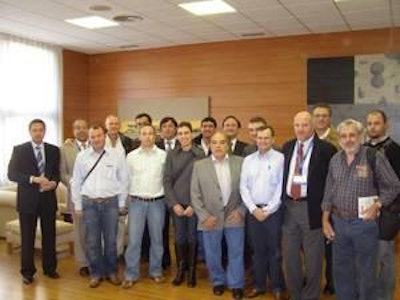
Without a doubt the year 2008 was disastrous for pig production in Spain, while 2009 has brought the global crisis. Despite all this, however, the ninth edition of the biennial Spanish international livestock production show called FIMA Ganadera could be counted a total success. It received close to 55,000 visitors and there were 810 exhibiting companies on 75,000 square metres of display space.
The exhibition was the starting point of a Spanish tour by 12 delegates from some of the most important companies in the Brazilian pork industry, organised by consultancy group OPP International of Lerida in Spain in close coordination with leading Brazilian advisory team Integrall. This tour focused mainly on new production systems meeting animal welfare legislation.
Europe’s pig sector has started to draw interest from the Brazilian pig industry ever since Russia began increasing its own local production and therefore affecting Brazil’s export expectations. Brazil exports close to 40% of its pigmeat and Russia historically has been one of the main targets.
Now the expanding Brazilian industry is starting to understand it should design at least part of its new and projected production facilities towards being animal friendly systems, if it want to access all the global market.
Many Brazilian companies have expansion projects, an although they probably wont start construction this year, as planed, they expect to start them as soon as the global crisis is over.
The Brazilian delegation had a representative form the Sadia (230.000 sows), Perdigao (210,000 sows), Master, ASA, and others. The president of the Brazilian Pig Producers Association, Rubens Valentini, also assisted, as well as members of the Integrall consultancy which takes care of the health of almost 100,000 sows. Together, all these visitors accounted for more than 500,000 sows.
In order to explain the real magnitude of the changes that have to happen in the corporate culture of a company when it considers going into welfare friendly systems, OPP decided to assemble a trip that had not only lectures and farm visits, but also the opportunity to meet some of the leading companies that provide service and products to the Spanish pig sector.
Dr Joan Sanmartin, director of OPP, explains: “We wanted to show the Brazilian delegates that applying animal welfare systems to large scale farms implies deep changes in genetics, nutrition, disease patterns and management. It is not only about changing the farm layout and equipment.”
Visits included to health products company Hipra and its diagnostic laboratory Diagnos, where nearly half a million samples a year are processed for clients — anything from serum samples for ELISA to tissues for PCR. From there, the delegation visited Group Batallé, a family company that has major interests in slaughtering, meat processing and genetics. The agenda then took them to Ejea de los Caballeros, where they visited a boar stud, a farm under construction and a unit in operation.
At Magapor facilities the group discussed the use of new techniques such as intra-uterine+postcervical AI compared to conventional systems. The tour ended by visiting nutrition company Ingaso for discussions of young-pig diets, antibiotic substitution and early growth.
At the FIMA show itself, with other visitors I found the pig equipment section extremely interesting for the number of innovations on view. For example, the heating products included a new MIK Thermo W 500 600 floor heater described as the most energy-efficient flooring on the market. Designed to be mounted into farrowing crates or weaner pens, it was claimed to be 20-30% more cost-effective than other options.
Austrian firm Schauer, at the stand of their Spanish representative firm Infoporc, exhibited the Compident sow feeding station and the Spotmix multi-phase residue free feeding system. According to Infoporc, these ESF sow feeding stations are being chosen by a number of Spanish herds for the conversion of their gestation facilities into group housing in line with the EU’s coming animal welfare rules.
Systems of this type are reportedly going into most new projects being presently installed in Spain for inventories of up to 2400 sows.
Spanish breeding supplies specialist Magapor brought its well-known line of semen extenders and AI laboratory equipment, but also two major innovations in the form of Duragen and MagaPlus DD. Duragen is an extra-long duration semen extender which conserves viable semen up to 12-15 days.
The company referred to MagaPlus DD as a double deposition extra-long catheter which allows a simultaneous post-cervical and deep intrauterine insemination. It was being marketed as offering the triple advantage of speed, simplicity and precision with a low AI dose of just 50-90 ml.
For pig identification purposes, I particularly liked the CC 387 Sira AZASA. This is a hand-held or palm reader of electronic ear-tags. Developed in Spain, it impressed me for the fact it is light, robust and easy to use, yet it can save up to two million data recordings.

















